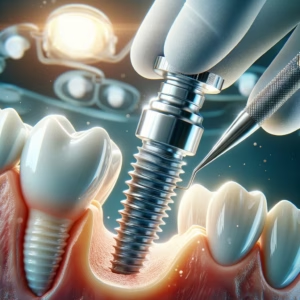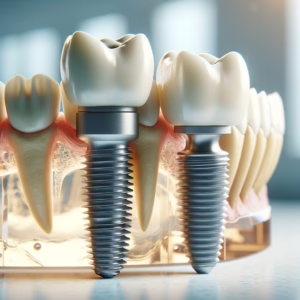Introduction to Dental Implants
Introduction to Dental Implants
Dental implants are a modern dental solution designed to replace missing teeth and restore both function and aesthetics to your smile. Comprised of a titanium post that serves as a replacement tooth root, dental implants are surgically placed into the jawbone. Over time, they fuse with the bone in a process known as osseointegration, providing a stable and durable foundation for artificial teeth, such as crowns, bridges, or dentures.
Purpose of Dental Implants
The primary purpose of dental implants is to restore the functionality of your teeth, allowing you to chew, speak, and smile with confidence. They also play a crucial role in maintaining the structure of the jawbone, which can deteriorate when teeth are missing. This preservation of bone health is essential, particularly for seniors, as it helps maintain facial features and prevents further dental complications.
Benefits of Dental Implants
Dental implants offer numerous benefits that make them a preferred choice for tooth replacement:
- Durability: With proper care, dental implants can last many years, often a lifetime, making them a cost-effective solution over time.
- Natural Appearance: Implants are designed to look, feel, and function like natural teeth, enhancing your smile and restoring confidence.
- Improved Oral Health: Unlike traditional bridges that require the alteration of adjacent teeth, implants do not compromise surrounding teeth, allowing for better overall oral health.
- Enhanced Comfort: Dental implants eliminate the discomfort often associated with removable dentures, as they are securely anchored in place.
- Ease of Maintenance: Caring for dental implants is straightforward, requiring regular brushing, flossing, and routine dental check-ups, similar to natural teeth.
How Dental Implants Differ from Other Restoration Options
While there are several options available for tooth restoration, such as dentures and dental bridges, dental implants stand out due to their unique advantages.
- Dentures, while a more affordable option, can shift or slip within the mouth, potentially causing discomfort and affecting speech and eating. They also require more maintenance and may need to be replaced or relined periodically.
- Bridges require the alteration of adjacent teeth for support, which can compromise their health over time and may lead to further dental issues.
In contrast, dental implants offer a more permanent solution that does not require changes to adjacent teeth and provides the stability and functionality most similar to natural teeth.
Importance for Seniors
Understanding dental implants is particularly important for seniors, as they often face unique dental challenges due to age-related factors such as bone loss, gum disease, and the wear and tear of natural teeth. By considering dental implants, seniors can regain their quality of life through improved oral health, enhanced nutrition, and increased confidence in their appearance.
This guide aims to provide a comprehensive overview of dental implants, equipping seniors with the knowledge they need to make informed decisions about their dental health. Whether you are exploring options for replacing missing teeth or seeking to understand the benefits of dental implants, this information will serve as a valuable resource on your journey to achieving a healthy and beautiful smile.
Types of Dental Implants
Types of Dental Implants
Dental implants can be categorized into two primary types: endosteal implants and subperiosteal implants. Each type is designed to address different needs and circumstances, particularly for seniors who may have specific health and bone density considerations.
Endosteal Implants
Definition: Endosteal implants are the most common type of dental implant. They are surgically implanted directly into the jawbone. Once the bone heals around the implant, it becomes a stable foundation for attaching a crown or other dental prosthesis.
Examples: Endosteal implants typically come in the form of screws, cylinders, or plates. Titanium is the material of choice due to its biocompatibility and strength.
Suitability for Seniors: For seniors with adequate bone density, endosteal implants are often the preferred option due to their longevity and stability. However, seniors with significant bone loss may require additional procedures, such as bone grafting, to prepare the jawbone for implantation.
Subperiosteal Implants
Definition: Subperiosteal implants are placed under the gum but above the jawbone. A metal framework is fitted to the existing bone, and as the gum heals, it secures the framework in place. This type of implant is less common and typically recommended for patients who do not have sufficient bone height for an endosteal implant.
Examples: Subperiosteal implants consist of a metal structure that is custom-made to fit the patient’s jawbone. Posts protrude through the gums to hold the dental prosthesis.
Suitability for Seniors: Subperiosteal implants can be an effective solution for seniors with considerable bone loss who cannot undergo bone grafting. This type avoids the need for extensive surgical procedures, making it a viable option for those with overall health concerns or those who may not tolerate more invasive surgery well.
Considerations for Seniors
When determining the most suitable type of dental implant for seniors, several factors should be taken into account:
Overall Health: A senior’s general health status can influence the choice of implant. Those with chronic conditions may need to discuss the risks and benefits of each type with their healthcare provider.
Bone Density: Adequate bone density is crucial for the success of endosteal implants. Seniors with osteoporosis or significant bone loss might find subperiosteal implants to be a more appropriate choice.
Surgical Recovery: A patient’s ability to recover from surgery is vital. Endosteal implants typically require more extensive surgical procedures and longer recovery times compared to subperiosteal implants.
In conclusion, understanding the differences between endosteal and subperiosteal implants can help seniors make informed decisions about their dental health and choose the option that best aligns with their individual needs and circumstances. By collaborating with their dental and healthcare providers, seniors can ensure they select the most suitable implant type for restoring their smiles and improving their quality of life.
The Dental Implant Procedure
The Dental Implant Procedure
The process of obtaining dental implants involves several stages, each crucial for ensuring a successful outcome. Below is a step-by-step outline of what to expect from the initial consultation through the surgery and healing phases.
Step 1: Initial Consultation
During the initial consultation, the dentist will conduct a comprehensive evaluation of your oral health. This may include:
- Medical History Review: Discussion of your overall health, current medications, and any underlying medical conditions that could affect the procedure, such as diabetes or osteoporosis.
- Dental Examination: A thorough examination of your gums and teeth, along with dental X-rays or 3D imaging to assess bone density and structure.
- Treatment Planning: Based on the findings, the dentist will develop a personalized treatment plan tailored to your needs and goals.
Step 2: Preparation for Surgery
Prior to the actual surgery, certain preparatory steps may be necessary:
- Bone Grafting: If there is insufficient bone density to support the implant, a bone graft may be recommended. This procedure involves adding bone material to the jaw to create a stable foundation for the implant.
- Extractions: If any remaining damaged teeth need to be removed, these will be extracted during this phase.
Step 3: Surgical Placement of the Implant
The surgical placement of the implant is typically performed under local anesthesia or sedation. The procedure includes:
- Incision: The dentist will make a small incision in the gum tissue to expose the jawbone.
- Implant Insertion: A titanium post (the implant) is carefully inserted into the jawbone.
- Closure: The gum tissue is stitched back over the implant, and a healing cap is placed on top.
Step 4: Osseointegration Phase
Following the surgery, a healing period is necessary for osseointegration to occur, where the bone fuses with the implant. This phase can last anywhere from several weeks to a few months, depending on individual healing rates. During this time, it is essential to maintain good oral hygiene and attend follow-up appointments.
Step 5: Abutment Placement
Once osseointegration is complete, the dentist will perform a minor surgery to attach an abutment to the implant:
- Abutment Insertion: The healing cap is removed, and the abutment (a connector piece) is placed on the implant.
- Gum Healing: After the abutment is placed, the gums will need time to heal around it, which usually takes a few weeks.
Step 6: Final Restoration
With the abutment in place and the gums healed, the final restoration can be completed:
- Impressions: The dentist will take impressions of your mouth to create custom crowns, bridges, or dentures that will be attached to the abutment.
- Placement of Final Restoration: The custom-made prosthetic teeth are then carefully fitted and secured to the abutment, completing the dental implant process.
Healing and Aftercare
After the final restoration, some care considerations include:
- Pain Management: Mild discomfort or swelling can be managed with prescribed medications or over-the-counter pain relievers.
- Follow-Up Visits: Regular follow-up appointments will help ensure the healing process is on track and that the implants are functioning correctly.
- Oral Hygiene: Maintaining good oral hygiene is vital for the longevity of your implants. Brush and floss regularly, and consider using an antibacterial mouth rinse.
Special Considerations for Seniors
Seniors pursuing dental implants may face specific challenges, but many can successfully benefit from this procedure. Considerations include:
- Bone Density: Age-related bone loss may necessitate bone grafting prior to implant placement.
- Medical Conditions: Conditions such as diabetes, heart disease, or osteoporosis should be carefully managed and discussed with your dentist to ensure a safe procedure.
- Healing Time: Seniors may experience a slower healing process, requiring patience and adherence to aftercare instructions.
By understanding the dental implant procedure and considering the unique needs of seniors, individuals can achieve a revitalized smile and improved quality of life through this effective tooth replacement option.
Choosing a Provider in Ashburn, VA
Choosing a Dental Implant Provider in Ashburn, VA
Selecting the right dental implant provider is a crucial step for seniors considering this procedure. A well-chosen provider can significantly impact the success of the treatment and the overall experience. Here are key factors to consider when making this important decision:
1. Credentials and Qualifications
It is essential to verify the credentials of the dental implant provider. Look for dental professionals who are board-certified and have specialized training in implantology. Membership in professional organizations, such as the American Academy of Implant Dentistry (AAID) or the International Congress of Oral Implantologists (ICOI), can also indicate a commitment to ongoing education and adherence to industry standards.
2. Experience and Expertise
Experience plays a vital role in the success of dental implant procedures. Inquire about the provider’s experience specifically with dental implants, including the number of procedures performed and their success rates. A seasoned provider will be more adept at handling complex cases and potential complications, which is particularly important for seniors who may have unique oral health considerations.
3. Patient Reviews and Testimonials
Reading patient reviews can provide valuable insights into the quality of care and patient satisfaction. Look for testimonials on the provider’s website, social media platforms, and third-party review sites. Pay attention to feedback regarding the overall experience, including the staff’s professionalism, the office environment, and the effectiveness of the treatment. Recommendations from friends or family members can also be a helpful resource.
4. Technology and Techniques Used
Advancements in dental technology can enhance the accuracy and efficiency of dental implants. Inquire about the technology the provider uses, such as 3D imaging for treatment planning or computer-guided implant placement. Providers who invest in modern technology may offer minimally invasive techniques, which can lead to quicker recovery times and reduced discomfort.
5. Comprehensive Treatment Plans
A thorough consultation process is crucial for understanding the treatment plan. The provider should conduct a comprehensive evaluation, including medical history assessment, X-rays, and possibly a CT scan, to determine the best approach for your specific needs. Ensure that they take the time to explain the procedure, expected outcomes, and any potential risks involved.
6. Follow-Up Care and Support
Post-operative care is an essential aspect of dental implant treatment. Ask about the follow-up procedures and support the provider offers after the surgery. A good dental implant provider should maintain open lines of communication for any questions or concerns that arise during the healing process.
Tips for Seniors to Research and Find the Right Provider
Start with Referrals: Ask your primary care physician, dentist, or friends for recommendations. Personal experiences can guide you to trusted providers.
Utilize Online Resources: Use websites that specialize in health care provider reviews, such as Healthgrades or Zocdoc, to gather information on providers in Ashburn.
Schedule Consultations: Consider scheduling consultations with multiple providers to compare their approach, personality, and the comfort level you feel with them.
Ask Questions: Prepare a list of questions to ask during your consultations, covering topics such as experience, techniques, and post-operative care.
Verify Insurance and Financing Options: Check whether the provider accepts your insurance plan and inquire about financing options. Many providers offer payment plans that can make dental implants more affordable.
By carefully considering these factors and utilizing the tips provided, seniors can make informed choices when selecting a dental implant provider in Ashburn, VA, ensuring a positive experience and successful outcome.
Aftercare and Maintenance
Aftercare and Maintenance
Caring for dental implants is crucial for ensuring their longevity and maintaining overall oral health. Here are some key aspects of aftercare and maintenance specifically tailored for seniors.
Oral Hygiene Practices
Daily Brushing: Brush your dental implants twice a day with a soft-bristled toothbrush and non-abrasive toothpaste. Pay special attention to the gum line to remove plaque buildup, which can lead to gum disease.
Flossing: Floss daily using unwaxed dental floss or special floss designed for implants and bridges. This helps remove food particles and plaque from hard-to-reach areas, preventing inflammation of the surrounding gums.
Antimicrobial Mouthwash: Consider using an antimicrobial mouthwash to help reduce bacteria in your mouth. This can be particularly beneficial for seniors, as oral health can decline with age.
Water Flossers: Using a water flosser can be an effective way to clean around dental implants, especially for those with reduced dexterity. It can help flush out debris and bacteria from around the gum line.
Avoid Tobacco Products: Smoking or using tobacco can hinder healing and increase the risk of implant failure. Quitting or reducing tobacco usage can significantly improve oral health.
Regular Dental Check-ups
Regular dental check-ups are essential for maintaining the health of your dental implants and surrounding teeth. Seniors should aim for dental visits every six months, or as recommended by their dentist. During these visits, your dentist will:
- Inspect Implants: Assess the condition of your dental implants and surrounding tissues to ensure they are healthy and functioning correctly.
- Professional Cleaning: Perform professional cleanings to remove tartar and plaque buildup that regular brushing and flossing may miss.
- Monitor Bone Health: Check for any signs of bone loss around the implants, which can be a concern for seniors.
Importance of Aftercare Practices
Adhering to these aftercare and maintenance practices is vital for prolonging the lifespan of dental implants. Proper oral hygiene helps prevent infections, gum disease, and other complications that can jeopardize the integrity of the implants. Moreover, maintaining regular dental appointments allows for early detection and intervention of potential issues, ensuring that your implants remain a healthy and functional part of your smile for years to come.
By prioritizing oral hygiene and regular check-ups, seniors can enjoy the full benefits of dental implants, including improved quality of life and enhanced overall health.
Conclusion and Next Steps
Conclusion and Next Steps
In summary, dental implants offer a durable, natural-looking, and effective solution for replacing missing teeth, especially beneficial for seniors facing unique dental challenges. The advantages of implants, including their stability, comfort, and preservation of oral health, make them a superior choice compared to traditional options like dentures and bridges.
If you are considering dental implants, the next step is crucial: consult with a local specialist to explore your options. Scheduling a consultation with a qualified dental professional in Ashburn, VA, will provide you with personalized insights and guidance tailored to your specific needs. Taking this step can help you regain your confidence, improve your oral health, and enhance your quality of life.






